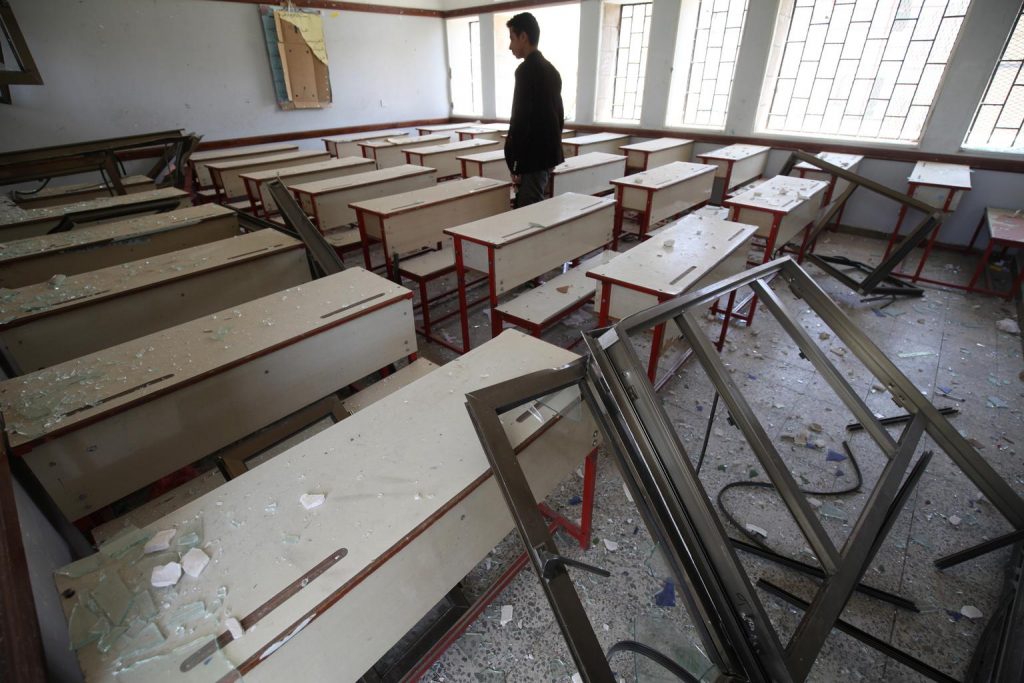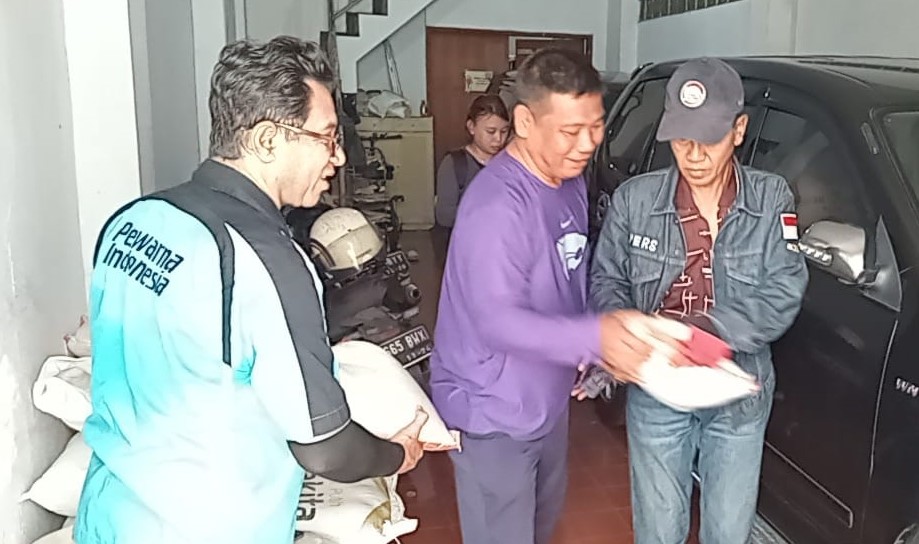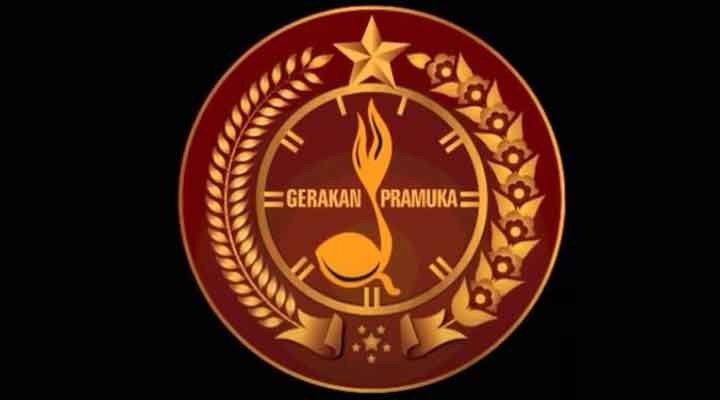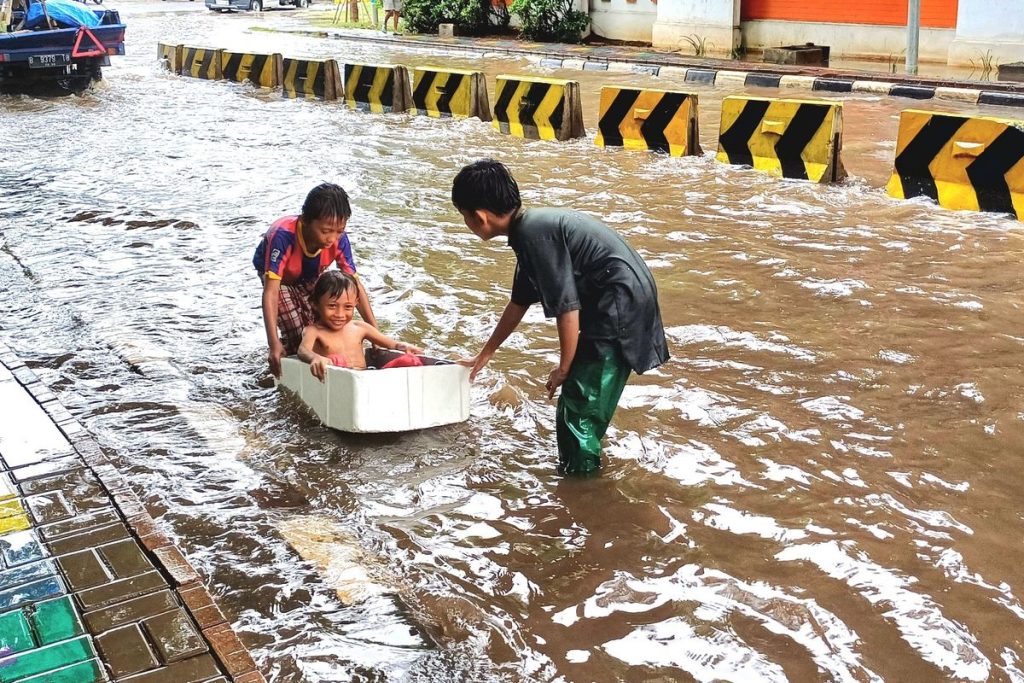UNICEF: Hentikan Kekerasan pada Remaja Sekarang Juga! #ENDviolence
Written by rpkfm on 7 September 2018

UNICEF Goodwill Ambassador David Beckham plays football with students and teachers at the SMPN 17 school in Semarang, Indonesia, March 27, 2018. In February 2015, David Beckham and UNICEF launched a new, unique, multi-year initiative which aims to help UNICEF protect millions of children around the world from danger. This initiative is entitled 7: The David Beckham UNICEF FUND. The 7 Fund is on a mission to unlock incredible in every child. In Indonesia the 7 Fund will be targeting bulling and peer violence that keeps children away from school and supporting programmes that ensure that children, especially girls, feel safe to learn.
UNICEF Goodwill Ambassador David Beckham travelled to Indonesia to see how 7: The David Beckham UNICEF Fund is helping UNICEF to target bullying and peer violence that can keep children, especially girls, away from school. During the visit, David met children who have taken part in school based anti-bullying programmes. The visit announces the new focus for the 7 Fund to help children break down barriers and unlock their potential. © UNICEF/Indonesia/Modola

On 14 may 2015 in the village of Nikishino, in eastern Ukraine, only the ruins of school No. 185 still stand, as a result of the conflict.

Block: Patratu, District: Ramgarh, City: Ranchi, , State: Jharkhand, Country: India, 10th May 2018
Adolescent girls react as they participate in a story book reading session “Paheli ki Saheli” on Menstrual Health and Hygiene Management for Adolescents Girls project (MAHIMA) an initiative of UNICEF at Kasturba Gandhi Balika Aavasiya Vidyalaya (KGBV) in Patratu.
Unicef in collaboration with the Government of Jharkhand, Development Network (DevNet), and Loharganga Gram Swarajya Sansthan (LGSS), implemented an initiative to improve Menstrual Health and Hygiene Management (MHHM) among adoloscent girls in two districts of Jharkhand.
©UNICEF India/2018/Prashanth Vishwanathan

[NAME CHANGED] (right) Javier, 10, and his grandmother Gabriel walk to the UNICEF-supported Carlos Alberto Rivera Hernandez School in San Pedro Sula, Cortes, Honduras, Friday 8 April 2016. Javier’s father and five uncles were killed in gang violence over a period of two years and his mother abandoned him. He now lives with his grandmother Gabriel in the neighbourhood.
Javier has not been threatened or attacked by gang members, but he has friends in the older years who have experienced violence and are too scared to come to school. A 15-year-old girl was killed, having been tortured for two days in a neighbourhood known as ‘casa loca’ (crazy house). Javier only attends school in the morning. Gang members tend to send in ‘flags’ to monitor activity and recruit students in the afternoon. “There is a lot of violence here. I want to be a doctor so I can help people who are hurt”.
With 57 homicides per 100,000 residents in 2015, Honduras has one of the highest murder rates in the world. Organized crime grew in the wake of civil wars in the region, which left many people unemployed and with easy access to weapons. As of August 2016, heavily armed gangs have tens of thousands of members in Honduras and neighbouring countries, where they engage in extortion, assassinations, drug trafficking, car theft, illegal gun sales, kidnappings and turf wars.
Instead of being safe learning environments, schools have become recruiting territories for the gangs. Many children and adolescents who attend school must make dangerous trips from their homes to places of education. Once at school, they run the risk of being recruited, threatened, abused, attacked and even killed. The cycle of violence puts many children at risk of physical violence, increasing school dropout rates, as children fear continuing their education.
To address these problems, UNICEF is working with communities to create safe schools. UNICEF supports partners such as the COMVIDA Outreach Centre, which

On 03 March, a destroyed school room at Gerver Seconday School in the Zumar sub-district of Ninewa Governorate, Iraq. Much of the school was damaged when the area was occupied by militants earlier this year.
UNICEF implementing partner People in Need (PIN) is facilitating the reopening of 10 schools and the enrollment of returnee students in the Zumar sub-district of Ninewa Governorate after armed groups were forced to retreat from the area earlier this year and displaced families were able to return home.
Most schools in Zumar are now open and children have returned to class, but the buildings are in dire need of reconstruction – some lack proper water and sanitation, gender separate bathrooms, or their equipment was looted during the conflict. Some parents are still afraid to send their children to school, especially if the school is far away. There are very few women teachers, which makes it more difficult for female students to attend.
Most students who are now returning to class have missed months of education while they were displaced from the area due to conflict. After the turmoil of displacement, restoring access to education is essential.
With generous contributions from the governments of Canada, Japan, Ireland and Germany, in the last year as part of the overall response to the crisis in Iraq, UNICEF and parters provided access to education to nearly half a million children through building new schools, installing prefabricated classrooms, establishing temporary learning spaces, and distributing learning materials.
However, the impact of conflict, violence and displacement has devastated Iraq’s education system. Nearly 2 million children are currently out of school, with an additional 1.2 million at risk of dropping out. Almost 1 in 5 schools across the country cannot be used as a result of the ongoing conflict. Of the schools that remain in use, thousands are overburdened, with large class sizes and many schools operating in multiple shifts.

On 28 April, the son of the guard at Ibn Sina School walks through rows of desks while checking a damaged classroom in the facility, in Sana’a, the capital. The school was heavily damaged during an air strike that hit the building next to the school. The impact of the blast crumbled the outer wall of the schoolyard and left classrooms covered in rubble and broken glass. The school, where 1,500 girls studied in primary and secondary classes, is closed indefinitely.
By 30 April 2015 in Yemen, escalating conflict continued to exact a heavy toll on children and their families. Some 300,000 people have been internally displaced. Casualties have reached 1,244, including 115 children, and 5,044 people have been injured, including 172 children. Prior to the current crisis, 15.9 million people – including 7.9 million children – were already in need of humanitarian assistance. The conflict has left many schools closed and nearly 2 million children unable to attend classes. UNICEF has verified that at least 30 schools have been damaged by fighting, exacerbating an already dire situation. Even before the recent conflict, 1.6 million children were already out of school. The country’s humanitarian crisis is also deepening because fuel shortages are reaching critical levels, and access to food and clean water are becoming more difficult by the day. The international airport in Sana’a, the capital, was bombed on 28 April, leaving both landing and take-off runways destroyed; this has prevented humanitarian supplies from getting into the country by air. The airport in the city of Hodeidah was also attacked on the same day, causing the same level of damage. Seaports are now the only viable entry point for humanitarian supplies. UNICEF support spans such vital sectors as nutrition, water, sanitation and hygiene (WASH), health, child protection and education. UNICEF has appealed for US$88.1 million to cover responses through December 2015.

On 12 March 2015, Zina, 9 years-old, shows her drawing, which describes story of her family when they went through check point to get away from shelling in the city of Sloviansk. Her hometown, Sloviansk, was occupied from April to July 2014, during which time she was unable to attend school, go to dance classes with her sister or play outside with her friends. She fled with her family when the shelling began, but is now back in Sloviansk. “ I have some very unpleasant memories of the time when fighters occupied our town. We had a school break in April and never managed to get back to studying. I was frightened to go to school because there were checkpoints at every corner; armed men were inspecting the documents of mum and dad, opening a trunk, checking the car from inside. My sisters and I, we were no longer able to attend dance classes, because local Cultural Centre was occupied by fighters. When we went to this Centre with my mum the other day, there were sandbags and shotguns sticking out from the open windows. We got really scared and returned home. We weren’t leaving our house, weren’t going out to see our friends, we weren’t studying or having some extra-classes like we used to. And then the shelling began. Fighters were driving down to our street on the airborne assault vehicle, some fragments of mines broke our window and parts of the roof. Mom realized that we could be killed any day, and so our parents packed up, took our documents and we left for Dnipropetrovsk.” Zina continues “Now Sloviansk is freed, but still there is fighting happening very close to us, children are dying. I feel unsafe when I hear from my parents what is being said on the news: a conflict can start at any moment. This is terrifying.”

On 16 September, Shaima, 10, and a classmate hold hands while standing beside rubble from a destroyed part of Shuje’iyah Girls’ School in Shuja’iyeh neighbourhood in eastern Gaza City. Ten days into the recent escalation of violence between Israel and Gaza, her family moved to her grandfather’s ground-floor apartment, which was thought to be a safer place. “Early morning, the shelling got closer,” Shaima says. “Suddenly a bomb fell nearby. Everyone ran out, except for my father and younger sister. I heard people scream that he was dead.” Her father, Adel, was on the sofa in the living room with her 2-year-old sister, Dima, in his arms, trying to rock her to sleep, when a shell struck the neighbour’s house. Both Adel and Dima were killed by shrapnel that came bursting through the walls. “I saw my uncle carrying my sister,” Shaima recalls. “I realized her head was cut off in the shelling. I didn’t look at my father’s body, because I was afraid his wounds were as bad. I ran away.” Now she is visited regularly by a counsellor from the Palestinian Centre for Democracy and Conflict Resolution (PCDCR), a UNICEF partner that specializes in child trauma. The counsellor sees her at home and helps her talk about her experience. “I was not able to say goodbye to my dad,” Shaima tells the counsellor. “I don’t want to be an orphan; I want my dad to be with me. I only have wonderful memories of him. He used to buy me toys, even if I did not ask for them. I wish I could see him and my sister Dima again. I used to play with her. I liked to dress her and comb her hair.”
In September 2014 in the State of Palestine, children continue to recover from 50 days of intense violence that engulfed the territory during July and August. The conflict – which ended with a ceasefire on August 26 – left 506 children dead and more than 3,000 injured, while destroying an estimated 18,000 houses in Gaza.

12-year-old Myrianne Navanga confidently writing up to the board in class with her friend, in the village of Man, in the North West of Côte d’Ivoire. Myrianne is albinos which means her skin lacks pigmentation.
‘I don’t mind that I have albinism because I know that my skin just lacks pigment. I don’t have a disease and I’m not from a different race.’
Sadly, not all albinos grow up in an inclusive environment like Myrianne in Côte d’Ivoire. Some of them face bullying and stigma from childhood, all the way through school and even as adults.
But the story of Myrianne is a happy one and she is full of projects: ‘When I grow up, I would like to be a nurse. Every child should be able to go to school to succeed in life.”
For every child, equality.

On 11 August 2016, a primary school destroyed in conflict in Bentiu, Unity State. Years of war have destroyed the infrastructure of education in South Sudan. One out of every three schools in the country are either damaged, destroyed, occupied or closed. Fifty percent of children are out of school in South Sudan, the highest proportion in the world. UNICEF in 2016 launched the Back to Learning 2 campaign targeting 590,000 children with learning opportunities.
South Sudan has one of the highest proportions of children out of school in the world, that is 1.8 million children with an unclear future. With a low primary enrolment rate, around 40 percent, less than 14 percent complete the 8 year primary cycle. Only 30 per cent of those enrolled are girls and only 1 out of 10 girls complete the primary education cycle. Incidents of children dropping out of school has recently increased due to economic crisis and food insecurity as well as recent violence in Juba and Wau.

On 10 August 2016 in the Syrian Arab Republic, a displaced child from al-Hamadaniyah neighbourhood in the western part of Aleppo, now stays at a school turned into a shelter.
By end August 2016, children continue to bear the brunt of the latest surge in violence in Aleppo. In the eastern part of Aleppo, around 100,000 children remain trapped since early July. Water has ceased flowing through the public network, as the generator that operates the main water pumping station needs urgent repairs. UNICEF does not have safe access to provide the urgent humanitarian assistance needed in the area.
In the western part of Aleppo, an estimated 35,000 people were displaced when new waves of fighting hit the al-Hamadaniyah neighbourhood. Already displaced by the war and living in half-built apartment towers, again families had to flee and leave everything behind. Most families are currently staying in informal shelters such as schools and mosques as well as in parks and on the streets. UNICEF trucks in water daily for 300,000 of the most vulnerable people including newly displaced families in informal shelters. The main electricity network that powers pumping stations sustained damage in recent fighting. UNICEF supports the delivery of fuel to operate generators for water pumping stations and groundwater wells that provide safe drinking water to around 1.2 million people.

On 3 March 2016 in South Sudan, Chubat (right), 12, sits with her friend in the burned ruins of her school in Malakal Protection of Civilian site. The UNICEF supported primary school was burnt down in fighting on 17-18 February 2016, that left at least 18 people dead. Chubat and her friend used go to the school every day and enjoyed learning new things, especially during their English and math classes.
470 children attended grades 1 through 6. The school had five classrooms and seven teachers who taught English, Social Science, Christian Religious Education, and Mathematics. Due to the lack of space in the PoC, the same classrooms were used for CFS activities in the afternoon.
In 2016, UNICEF launched the second phase of the Back to Learning initiative, targeting almost 600,000 children across the country. South Sudan has one of the largest number of children not attending school in the world.




 RPK FM
RPK FM